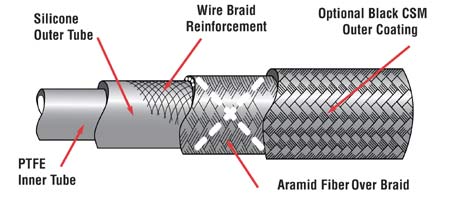Oil lines
Most race engines will feature a lubrication system with external oil lines, either to supply different sections of the engine with oil or to link to external components such as oil tanks. The design and construction of these lines can often be overlooked in the grand scheme of things; however, poor-quality lines can be disastrous for reliability, while good design and choice of material can bring considerable benefits in terms of vehicle packaging.
For many years the standard has been reinforced nitrile rubber hosing with a stainless steel overbraid. Pioneered for use in the aerospace industry, these provided both excellent strength and protection to vital lines and, when combined with screw-type end fittings, excellent reliability. While this was the benchmark for many years, the never-ending quest for reduced weight and more compact packaging in racecars has seen hose manufactures develop new types of hosing to help this cause.
The one big problem with standard reinforced rubber hosing is that there is a finite bend radius that can be achieved before the hosing begins to collapse in on itself, compromising flow. To overcome this, several manufacturers now offer hoses with a convoluted inner core, or alternatively a spiral 'spring' inner reinforcement. The convoluted core allows for the hoses to follow a much tighter radius without collapsing, an additional benefit being that the hose is better suited for use in vacuum applications thanks to the additional rigidity.
The only downside of the convoluted hose is the potential for reduced flow rates and the creation of unwanted turbulence. To counter this, several hosing manufacturers have created hybrid hoses that feature an inner hose with a convoluted outer surface and a smooth bore inside; giving excellent flow characteristics while still maintaining flexibility.
Another considerable improvement in hose construction has been the introduction of PTFE (polytetrafluoroethylene) to replace rubber in hose construction. PTFE has a number of advantages over rubber - notably, it is far more resistant to aggressive fluids such as biofuels with a high ethanol content, and some hydraulic fluids. More important though, especially in the case of oil systems, PTFE has a much higher temperature resistance than rubber, making it particularly useful in application where high temperatures are to be expected. For example, on some superspeedways, NASCAR teams will run oil temperatures in excess of 280 F (140 C), which is beyond the reliable temperature range of most rubbers; PTFE hoses are reliable beyond 400 F (205 C), making them an ideal choice.
The only disadvantage with PTFE is that it is not as strong as rubber, and thus needs additional reinforcement, so the construction of the hose differs. Generally a rubber hose will have fibres incorporated into its structure, added before curing, which increase its strength. In the case of PTFE hoses, most manufacturers will house the inner tubing in an outer sleeve made of a more resilient material, which can be either another hose, made of a material such as silicone, or a metallic of fibrous braided sleeve.

The final key area of development in hosing has been the materials used to protect the inner core. As mentioned, the traditional way to protect rubber hoses is by using a stainless steel overbraid, which provides a very abrasion-resistant covering. It is heavy, however, and where weight is an issue manufacturers have looked to new materials to provide protection. The most popular solution is to use Kevlar or Aramid fibres woven together to form a sheath, which provides a hard-wearing finish (though still not as substantial as stainless steel) for a fraction of the weight. For high-pressure applications, steel is still the favoured medium as its strength prevents expansion of the inner hose.
A quick glance through a hose supplier's catalogue will present a bewildering array of different hose types, with varied performance and price levels. It is therefore imperative that careful consideration be given to the type used and the potential benefits or disadvantages it can provide.
Fig. 1 - An example of a reinforced PTFE hose; note the use of a silicone outer sleeve around the PTFE inner
Written by Lawrence Butcher